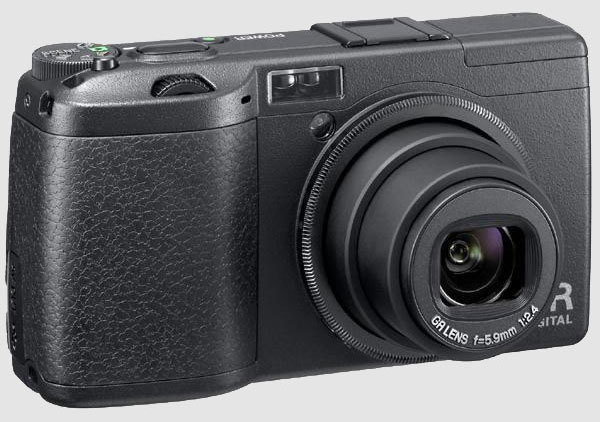TOPIC: CANON
Temptations, temptations...
19th August 2009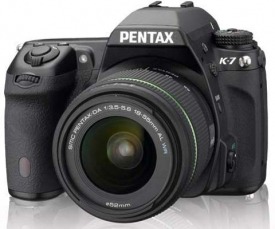
The last time that I went out and bought a new camera was over two years ago, and I am minded not to make another purchase for a while. Apart from damage to the battery cover arising from a fall, my Pentax K10D has survived so far without a problem and I admit to being satisfied with the photos that it makes. Following a professional sensor clean, my Canon EOS 10D has been pressed into service over the past few months, too. Meanwhile, 6 and 10 megapixel sensors generate nowhere near the attention that might have been the case a few years back, but that's by the by. In fact, the megapixel race seems to have stalled, with features like video being added to photographic cameras over the last year and live screens coming to prominence as well. Neither would make me rush out to buy a new DSLR anyway, perhaps because having things the old way suits me just fine and megapixel counts never ever moved me in the first place either.
That's never to say that the likes of Pentax's K-7 or Canon's EOS 50D and 5D Mark II don't capture my attention with their promises of better quality. However, with things the way that they are in the world, I am more likely to retain my cash or maybe invest in new photo processing software for making the most of what I already have. Ideas for photography projects creep into my head when I get to looking over my online photo gallery and realise that not have my tastes changed, while my photographic eye has developed too. That seeing of things in a new light may mean that old subjects get revisited, and I don't need a new camera to do that.
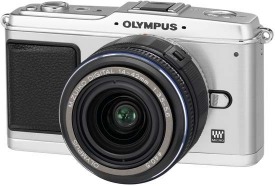
High-end compact cameras such as Canon's G11 and Ricoh's GR Digital III do detain attention for a while but a brief look at their prices proves that you really got to need the portability and I never can justify the outlay when a DSLR will do all that I want from it, and perhaps even for less money. While I admit to pondering the purchase of a GR Digital to cover for the EOS 10D while it was away for cleaning, the Pentax came to be acquired when I realised that the versatility of a DSLR was too much to lose, even for a while. Olympus' E-P1 may have bridged the gap, but the old question of going miniature for the price of a full sized article recurs.
All in all, I am going to stick with what I have right now. We are coming to a time of year when things appear more golden and that combination of lighting and colour are what really matters, not how many megapixels are in your camera sensor unless you are making large prints or supplying stock libraries. As long as my cameras continue to deliver pleasing results, I'll stick with elevating my skills and taking my time over that task, even with all the announcements of new cameras at various exhibitions and shows.
Another avalanche of new DSLR’s…
24th January 2008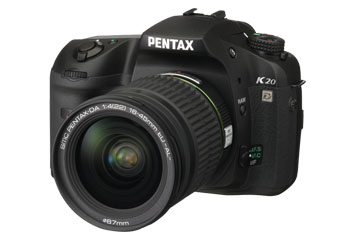
A flurry of new DSLR announcements came out today; they seem to come in droves when they do arrive, but I reckon that upcoming photography shows might have something to do with it. Canon replaced its entry-level offering with the 12.2 megapixel EOS 450D. Yes, I know that megapixels aren't everything, yet a goodly number does make a rather good impression and Canon's range looks a bit lop-sided again with the entry level DSLR on the surface of it having the potential for recording more detail than the next one up in their range, the EOS 40D. It almost seems that it would have been more sensible to delay the arrival of that camera until after the 450D and give enthusiasts a really impressive option.
As it stands, they might end up playing into the hands of Nikon with its D300, a strong contender if I were in the market looking for a DSLR. Pentax displays no such idiosyncrasies with its 10.2 megapixel K200D and its 14.6 megapixel K20D, while Samsung has also presented their variant of the latter: the GX200. It will be interesting to see reports of how all of these new arrivals perform. Launches like this do not take long to make your once shiny acquisitions look dated, and that fate certainly seems to have befallen my K10D. For some reason, that reminds me that my trusty old EOS 10D needs to be sent away for cleaning, a job that has been on the to-do list for a while.
What? No DNG?
9th January 2008Since Google's Picasa is now available for Linux, I decided to give it a spin. The availability of downloadable DEB packages made installation a piece of cake. It has been ported using WINE, which means that the look and feel is very much of the Windows world. The functionality is similar too, which means that it can seek out image files on your PC. However, it didn't find any DNG files for me, a surprise when DNG could become the standard raw camera format for digital imaging. In contrast, the lack of support for proprietary formats like Canon's CRW might be understandable. Because I like to review the raw image files before committing to editing them, Picasa will not suffice for this purpose, leading me to stick with what I already use.
A rake of new cameras
30th August 2007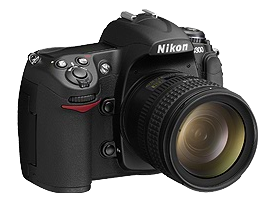 The websites of Amateur Photographer and Tech.co.uk are good places to find out what is happening in the world of digital cameras, which is just as well given the recent camera launching frenzy. It all seemed to start off with Canon's EOS D40 and EOS 1Ds Mark III.
The websites of Amateur Photographer and Tech.co.uk are good places to find out what is happening in the world of digital cameras, which is just as well given the recent camera launching frenzy. It all seemed to start off with Canon's EOS D40 and EOS 1Ds Mark III.
Even if the former seemed to be a case of playing catch up, I still think that Canon should have used the opportunity to pull ahead, at least in the megapixel stakes; Sony is working on a 12 megapixel offering and could be about cause of 12 megapixel sensors becoming the norm for consumer digital SLR's like they did with the 10 megapixel level. While I realise that megapixels aren't everything, it has seemed to go like that thus far. Playing catch up doesn't apply to the 1Ds Mark III given its having a monster sensor resolution of 21 megapixels and, needless to say, the improvements to the favoured DSLR of landscape photographers don't stop there.
Nikon were also in the fray with new 12 MP offerings: D300 for the enthusiast and D3 for the professional. The sensor in the latter interestingly features a sensor that sits between full frame and the more usual APS-C sizes. Panasonic has also announced a new DSLR, while a number of manufacturers have new digital compacts on the market too. All the previous makers have something, as does Olympus. It was astonishing to see this all happening at once, yet I suppose that's how it goes. Though IFA has been on over the last week, some launches preceded this; it's usually something big like Photokina that results in this sort of thing...
Update: I have discovered since the Nikon's D3 has a sensor sized in the full frame domain. It might be 36mmx23.9mm rather than 36mmx24mm, but the FX format comes extremely close and the advent of full frame DSLR's being purveyed by a number of manufacturers may be upon us.
Field testing my new Pentax K10D while out hillwalking
24th July 2007On Saturday, I happened to be in a branch of Jessops only to overhear a salesman emphatically state that you don't buy a camera for its specifications but for the photos that it produces. While his tone of voice was a touch condescending, and he seemed to be putting down a DSLR, he was essentially right. Nevertheless, the specifications do help you get the images, so they have to be seen in that light.
For instance, having on-board sensor cleaning may save you from having either to clean the thing yourself or send the camera away for the professionals to do what is needed, a much safer option in my view. And there may be occasions where image stabilisation is very useful, low light wildlife photography for instance. Yes, there are features that I consider surplus to requirements, like live viewing and movie capture, and that is very much due to my buying cameras to make photos. The salesman in question would surely have agreed...
Off to the Lakeland Fells
Sunday saw me head to the Lakeland Fells for some walking and a spot of testing of my new Pentax K10D. The details of the walk itself are not for here but for my hillwalking blog and that is where you will find them. While making my way from Crewe to Windermere, I perused the manual looking particularly for information pertaining to functions that I actually use, I should really have done this beforehand, but distractions meant that I hadn't got around to it. I had to wade through something designed for a new SLR user before I got to what I consider the important stuff. Though this may be a bit irritating, I can understand and accept why they do it this way; we were all new users once, and they are hardly likely to want to know about things like aperture priority, raw file capture, ISO control and such like straight away.
First Impressions of the Pentax K10D
What do I think of it then? Let's start with first impressions. It is definitely smaller than the Canon EOS 10D it accompanies in my possession. That said, it is not too small and there is a decent grip hosting the shutter release button and the camera on/off switch. It also feels well-assembled and reassuringly weighty, an important consideration given that it will see the outdoors a lot. A discussion of the features most relevant to me follows.
Power Management and Response Time
On the subject of switching on and off, the camera is set to go into a sleep mode after a second of inactivity, but it reawakens quickly when needed, the trigger being half-depression of the shutter release button. In fact, the camera does reawaken much faster than my Canon as it happens and where the delay is a constant source of some irritation.
Key Controls and Features
Even if it might sound strange, the on/off switch is also used to activate the depth of field preview, something that no SLR should not have. The location may be unusual, but maybe the designers thought that having shutter release and depth of field preview next to each was a logical way to do it. From a camera operation point of view, there is certainly something to that way of thinking.
Behind the shutter release, you'll find a screen that is a reminder of film SLR's. This conveys information such as battery life, number of exposures remaining on the card and exposure details (aperture & shutter speed).
Display and Menu System
Staying on the subject of screens, the one on the back of the camera is larger than that on the Canon. As is customary for these, it allows replay of photos taken and access to the various menus required to control the camera's operation. In comparison to the Canon, which is essentially a one menu affair with a thumb wheel controlling scrolling and an OK button at its centre to perform operations, the Pentax has a more elaborate system of submenus: one each for recording, playback and set-up.
The playback menu is where I found the setting that makes the camera highlight areas of underexposure and overexposure during image playback. This is something that I missed regarding the Canon until I happened upon it. Camera cleaning is located on the set-up menu, and the camera is now set to clean the sensor every time that it is turned on. Why this is not enabled by default is a little beyond me, but the designers might have thought that a vibration from the camera on turning it on could have resulted in a load of support calls. The same submenu also hosts memory card formatting.
File Format and Navigation Options
The recording submenu is where I set the camera to deliver RAW DNG files, an Adobe innovation, rather than the default JPEG's. There are other options like RAW PEF files, Pentax's own format, or RAW and JPEG simultaneously, but my choice reflects my workflow in Photoshop Elements; I have yet to stop the said software editing the DNG files, however.
With all these options, it is fortunate that there is a navigation wheel whose operation uses arrow buttons to get about. While on the subject of the back screen, there are further settings that are accessed with the FN button rather than the Menu one. These include ISO, white balance, shooting mode (single, continuous, timed and so on) and flash. The only setting that I changed out of this lot was to set the ISO to 400; I prefer to feel that I am in control.
Exposure Modes and Controls
Returning to the camera's top plate, the exposure mode dial is on the left-hand side, which is no hardship to me as this is in the same place as on the Canon. There are no scene modes, but the available exposure modes are more than sufficient: fully automatic, program, sensitivity priority, shutter priority, aperture priority, shutter and aperture priority, manual, bulb and external flash synchronisation.
A few of these need a spot of explaining. Sensitivity priority is a new one on me, but it is a consequence of the ability of DSLR's to offer a range of ISO settings; the aperture and the shutter speed are varied according to the ISO setting. Shutter and aperture priority is like manual exposure and is the inverse of sensitivity priority: set both aperture and shutter speed, and the camera will vary the ISO setting. Both of the foregoing assume that you let the camera set the ISO, but my setting the thing myself may have put paid to these functions.
Shutter priority and aperture priority are, as far as I can tell, their usual selves. For all exposure modes, the thumb wheels at the front and back of the shutter release handgrip set apertures and shutter speeds where appropriate, and this arrangement works well.
Metering Options
The focussing mode selector is found on the left of the body, next to the lens coupling. I am used to having this on the lenses themselves, so this is a new arrangement for me and one to which I can easily become accustomed. In fact, it is easy to find it while composing a picture. The modes themselves are manual focus, one-time autofocus and continuous autofocus; the last of these is for focussing on moving objects.
While I could go further, perhaps overboard, with a discussion of the features of this camera, I draw a line at what's here. Yes, it is useful to set the focussing point and activate image stabilisation, but the above are what matter to me and its performance in the photo making department is the most important aspect.
Performance in the Field
That neatly brings me to my appraisal of how it performs. With inspection of the first few images on the review screen, I was a little disappointed to see how dark the foreground was in comparison to the sky. When I brought everything home, as I always do, I found that things weren't necessarily as they appeared in the field. The Pentax more usefully offers histogram review and highlighting of any areas that are either underexposed or overexposed. It is these functions that I will be using in reshooting decisions while out and about with the Pentax, and the same can be said for how I currently use the Canon.
In fast changing lighting, the AE lock technique was a bit irritating, yet I am certain that I will get better at it. The autofocus doesn't always lock onto the subject, especially in tricky lighting, so manual focussing is a definite necessity and is more useful more for landscape photography, in fact. Nevertheless, the autofocus did do well most of the time, and my Sigma lenses have done worse things on me.
Conclusion
Overall, I'm satisfied with the K10D and plan to continue using it. My recent excursion yielded some quality photographs, which, as the Jessops salesperson would agree, is the ultimate purpose of any camera.
Windows Vista Upgrade Advisor
27th January 2007 Following the arrival of Vista, some are probably planning to upgrade straight away; I think that I'll wait a while. As it happens, we are using Windows 200 at where I work and the ending of Microsoft's support for this now elderly workhorse is driving a deployment of Windows Vista across the company that is due to start in the summer, a rapid turnaround in IT terms. Given that it wants people to upgrade to keep its coffers full, Microsoft has made a tool available a tool to test for Vista readiness. Oddly, you have to install it after download. While I would have thought that a tool like this should run without installation, there you go. Running it tells you the best version of Vista for you and any actions needed on your part. Vista Business edition was suggested as best for me and the deficiencies included: hard disk space on my Windows drive, a pair of incompatible devices and a number of applications whose compatibility could not be guaranteed. Curiously, some Microsoft packages turned up on the last list. As regards hardware, my sound card and scanner are the offending items. Sound cards are cheap if that needs to be replaced, but I had onboard sound capability on my motherboard that can be instated if so required. Throwing away a perfectly good Canon scanner isn't my idea of sustainable living, so I have been on a trip to the Canon website to find out more. The good news is that a driver update sets everything in order, though there are caveats for Vista 64 bit. All in all, a Vista upgrade is a goer.
Following the arrival of Vista, some are probably planning to upgrade straight away; I think that I'll wait a while. As it happens, we are using Windows 200 at where I work and the ending of Microsoft's support for this now elderly workhorse is driving a deployment of Windows Vista across the company that is due to start in the summer, a rapid turnaround in IT terms. Given that it wants people to upgrade to keep its coffers full, Microsoft has made a tool available a tool to test for Vista readiness. Oddly, you have to install it after download. While I would have thought that a tool like this should run without installation, there you go. Running it tells you the best version of Vista for you and any actions needed on your part. Vista Business edition was suggested as best for me and the deficiencies included: hard disk space on my Windows drive, a pair of incompatible devices and a number of applications whose compatibility could not be guaranteed. Curiously, some Microsoft packages turned up on the last list. As regards hardware, my sound card and scanner are the offending items. Sound cards are cheap if that needs to be replaced, but I had onboard sound capability on my motherboard that can be instated if so required. Throwing away a perfectly good Canon scanner isn't my idea of sustainable living, so I have been on a trip to the Canon website to find out more. The good news is that a driver update sets everything in order, though there are caveats for Vista 64 bit. All in all, a Vista upgrade is a goer.
Evaluating Photoshop Elements 5 after having been a user of Paint Shop Pro
26th January 2007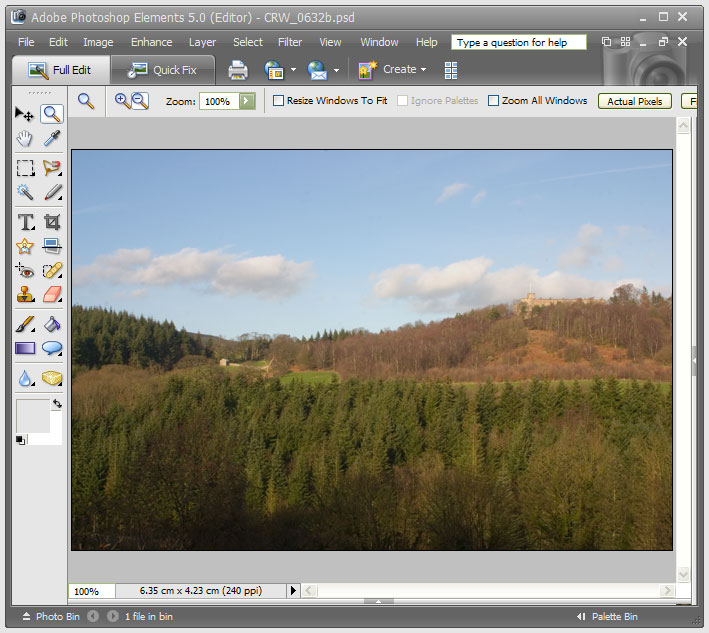
After having a trial version of Corel’s Paint Shop Pro Photo XI on evaluation, I have now moved on to the latest version of Adobe’s Photoshop Elements. Thanks to the digital photography revolution, image editing has become a lot more user-friendly these days. This is no doubt down to companies realising that investing in the development of this class of software does yield a return, and the development effort is progressing things very nicely indeed.
My first exposure to image editing was with Corel’s PhotoPaint, a low profile application that did what I asked of it while guzzling as much of what little memory my PC had in those days (32 MB first, then 64 MB). Paint Shop Pro 5, a popular tool of shareware origins, replaced this, though I must admit that I did briefly encounter the ubiquitous Photoshop at this stage. The PSP commitment continued through versions 7 and 9; though it is only in the later versions that photo processing began to be a significant part of the functionality. PSP XI has taken this further and has add-on tools like SnapFire for downloading photos from cameras. It does feature screen calibration as well, but I found that photos appeared very pale when using the calibrated workspace; maybe I set it up wrong. That said, its assistance in setting the brightness and contrast of my monitor was most useful. Until then, I hadn’t realised the details that I had been missing.
Nevertheless, Adobe’s Photoshop Elements has been able to inspire a certain level of confidence that PSP doesn’t. Even PE 2, which I got bundled with my Canon EOS 10D SLR, had that little extra when compared with PSP 9. For instance, it was PE where I saw the real power of the clone stamping tool. That different in air of confidence also extends to the latest generation.
So, I have found PE 5 worked quickly and that it became easy to generate good results. Features like the levels tool and “Save for the Web” are things that I have found very useful. There are a few minor disappointments, such as not showing the pixel size of the image being edited, a very useful feature of PSP. A bit of clarity around image resizing would also be nice, but I suspect that I may just need to learn a little more. Overall, its speed when it comes to creating nice results swings me away from PSP and may ultimately put paid to any loyalty that I may have owed to Corel’s image editor for the masses. While I think that I will have a go with its big brother, it looks as if I may well acquire PE 5 on a more permanent basis.
Camera tales
20th January 2007Anyone who has ever been on HennessyBlog will know that I enjoy walking in the countryside and that I always have a camera with me when I do. Like many digital SLR owners, I am beginning to see the tell-tale spots in my photos that are caused by a dirty sensor. And it isn’t that I am continually changing lenses either: I rarely remove the Sigma 18-50 mm DC zoom lens that I use with the camera. Rather than trusting myself with the cleaning (I have had a go already without much success), I am giving serious consideration to letting the professionals take care of my Canon EOS 10D, my only digital camera. I have already been quoted something of the order of £35 by a Canon service centre not far from me and am seriously considering taking them up on the offer.
Of course, sending it away to them means that I will have to forego the ability to include photos with posts on HennessyBlog describing my walks in the kind of timescale to which I have become accustomed; of course, this is where digital really scores. I will still have a camera with me as film remains my mainstay, even in this digital age. The camera in question is another Canon, an EOS 30 that I acquired used from Ffordes Photographic. While taking a recent peek at their website, I have just spied a used EOS 1V going for £399, a song for what remains Canon’s top of the range film SLR. Yes, I am tempted but I must stay real. In fact, I did not pay full price for my EOS 10D. That was part of the run-out stock that 7dayshop.com were selling off at next to half of the EOS 10D’s original asking price in the wake of its being superseded by the EOS 20D (itself since replaced by the EOS 30D: digital is a fast-moving world).
Sending a camera away for attention is not new to me as I also acquired a used Minolta X-700 manual focus SLR, again obtained from Ffordes, and that needed a spot of maintenance after a year in my possession. There was a problem with the shutter that cost me £75 to get Minolta to fix. Now that Minolta as a camera maker is no more, I was wondering who would attend to it in the future. That question was answered by a recent look on the web: in the UK it is JP Service Solutions, a division of Johnson’s Phototopia. Konica Minolta retain this information on their website. Konica Minolta’s failure to capitalise effectively on the digital revolution in its early days, particularly in the SLR area where they gifted their competitors a massive head start, cost them their future in the photographic business and now Sony continues the mantle, a sad end to one of camera manufacturing’s great innovators.
Returning to my digital-less dilemma, I suppose that I could get another digital for backup duty; I have to admit that a DSLR is a bulky contraption to be carrying in airline luggage. The camera that has made it onto my wish list is Ricoh’s GR Digital, a highly regarded offering that follows in the great tradition of its film forbears, the GR 1 and GR 21. Given that my first 35 mm camera was a Ricoh, and I have it still, this would be a case of returning to my roots. Of course, having it on a wish list is very different from having it on the to-do list and finances will certainly dictate if the purchase is made, though a finance deal offered by Warehouse Express does make it more accessible. Maybe some day…
